Araucaria heterophylla
Araucaria heterophylla (synonym A. excelsa) is a vascular plant in the ancient and now disjointly distributed conifer family Araucariaceae. As its vernacular name Norfolk Island pine (or Norfolk pine) implies, the tree is endemic to Norfolk Island, a small island in the Pacific Ocean between New Zealand and New Caledonia, about 1,440 km (890 mi) east of Sydney, Australia but is cultivated elsewhere as an ornamental. The genus Araucaria occurs across the South Pacific, especially concentrated in New Caledonia (about 700 km or 430 mi due north of Norfolk Island) where 13 closely related and similar-appearing species are found. It is sometimes called a star pine, Polynesian pine, triangle tree or living Christmas tree, due to its symmetrical shape as a sapling, although it is not a true pine.
| Araucaria heterophylla | |
|---|---|
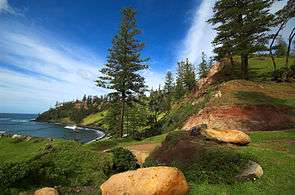 | |
| Norfolk Island pines, Norfolk Island | |
| Scientific classification | |
| Kingdom: | Plantae |
| Clade: | Tracheophytes |
| Division: | Pinophyta |
| Class: | Pinopsida |
| Order: | Pinales |
| Family: | Araucariaceae |
| Genus: | Araucaria |
| Section: | A. sect. Eutacta |
| Species: | A. heterophylla |
| Binomial name | |
| Araucaria heterophylla (Salisb.) Franco | |
| Synonyms | |
| |
History
The first European known to have sighted Norfolk Island was Captain James Cook. In 1774, on his second voyage to the South Pacific in HMS Resolution, Cook noted the presence of large forests of tall, straight trees that appeared to be suitable for use as masts and yards for sailing ships. However, when the island was occupied in 1788 by convicts transported from Britain, it was found that Norfolk Island pine trees were not resilient enough for those uses and the industry was abandoned.[2]
In the late 1950s, a trial shipment of Norfolk pine logs was sent to plywood manufacturers in Sydney, Australia, with the hope of developing a timber export industry on Norfolk Island. Although the plywood companies reported excellent results, the industry was deemed not sustainable by the Norfolk Island Advisory Council, which decided to reserve timber production for local use. The timber is good for woodturning and, together with the similar Cook pine, is extensively used by Hawaii artisans.
Description
It is a slow growing tree, reaching a height of 50–65 m (160–210 ft), with straight vertical trunks and symmetrical branches, even in the face of incessant onshore winds that can contort most other species. From the straight trunk, it emits its branches almost horizontal or slightly oblique, in number of five, forming floors; the plane of each floor is a perfect pentagon. If kept indoors, the tree remains smaller. The gray-brown bark falls off in fine scales. At the more or less horizontal to sometimes hanging branches, the branches are four to seven in regular whorls.
The young leaves are soft and awl-shaped, 1–1.5 cm (3⁄8–9⁄16 in) long, about 1 mm (1⁄32 in) thick at the base on young trees, and incurved, 5–10 mm (3⁄16–13⁄32 in) long and variably 2–4 mm (3⁄32–5⁄32 in) broad on older trees. The thickest, scale-like leaves on coning branches are in the upper crown. The cones are squat globose, 10–12 cm (4–5 in) long and 12–14 cm (5–6 in) diameter, and take about 18 months to mature. They disintegrate at maturity to release the nut-like edible seeds. The seeds have a length of 2.5 to 3 cm (1 to 1 1⁄8 in) and a diameter of about 1.2 cm (1⁄2 in) with wide wings. There are four cotyledons present. It is a dioecious tree (male and female flowers in different plants), although it can also be monoecious.
The scientific name heterophylla ("different leaves") derives from the variation in the leaves between young and adult plants.
Cultivation
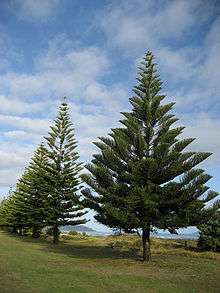
The distinctive appearance of this tree, with its widely spaced branches and symmetrical, triangular outline, has made it a popular cultivated species, either as a single tree or in avenues. When the tree reaches maturity, the shape may become less symmetrical. Despite the endemic implication of the species name Norfolk Island pine, the species is widely planted as an ornamental tree for its exotic, pleasing appearance and fairly broad climatic adaptability, and now occurs throughout the world in regions with suitable Mediterranean and humid subtropical climate. It grows well in deep sand, as long as it receives reliable water when young. This, and its tolerance of salt and wind, make it ideal for coastal situations. Indoors, the plant needs a bright, cool location for good growth. In summer it must not be exposed to the blazing sun; the temperature should not exceed 18 °C (64 °F). In winter, the plant needs a bright room that should be at least between 5 and 10 °C (41 and 50 °F).
Many of the "Norfolk Island pines" that grow in Hawaii, including their descendants used as potted ornamentals on the U.S. mainland, are actually Cook pines, the two species having been confused when introduced.
Uses
Young trees are often grown as houseplants in areas where the winters are too cold for them to grow outside (they will not, for example, survive outdoors in most of North America or Europe), and are sometimes used as Christmas trees. It will not survive in areas subject to prolonged cold. However, there are a few specimens growing outdoors in the subtropical gardens of Tresco Abbey Gardens on the Isles of Scilly, in the United Kingdom. What is probably the most northerly specimen growing outdoors is a young tree on Valentia Island on the southwest coast of Ireland. The tendency for potted saplings to develop a barren appearance can be helped by growing them in clumps. In northern climates they can be left outdoors during summer to promote fuller growth.
Large numbers of Norfolk Island pines are produced in south Florida for the houseplant industry. The bulk of these are shipped to grocery stores, discount retailers and garden centres during November. Many of these are sprayed with a light coating of green paint prior to sale to increase their eye appeal, although this may weaken or even kill the plant if it cannot photosynthesize adequately.[3] Some areas in the southern USA deserts and subtropical Florida prohibit the planting of Norfolk Island Pine due to the fact they can be struck by lightning and fall.[4]
Araucaria heterophylla has gained the Royal Horticultural Society’s Award of Garden Merit.[5]
Conservation
The species survival is not threatened at all by the houseplant trade, as it is grown commercially for potted plants. However, the native, natural stands of A. heterophylla were always restricted and have been much reduced since Capt. Cook's time. Farming, poor land management and the introduction of invasive species have reduced its population on the original three islands considerably. The main remaining stands are now within Norfolk Island National park and are therefore under some shelter.[6]
Gallery
 Cones and foliage of Araucaria heterophylla
Cones and foliage of Araucaria heterophylla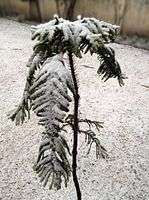 Snow on Araucaria heterophylla
Snow on Araucaria heterophylla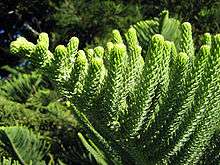 Araucaria heterophylla foliage from a mature tree
Araucaria heterophylla foliage from a mature tree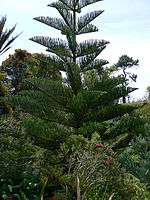 Araucaria on the Isles of Scilly, amongst the most northerly specimens growing outdoors
Araucaria on the Isles of Scilly, amongst the most northerly specimens growing outdoors
References
- Thomas, P. (2011). "Araucaria heterophylla". IUCN Red List of Threatened Species. 2011: e.T30497A9548582. doi:10.2305/IUCN.UK.2011-2.RLTS.T30497A9548582.en.
- The Fatal Shore. The epic of Australia's founding, Robert Hughes, 1987, Harvill Press, ISBN 0-394-75366-6
- Nelson, Jennifer Schultz. "3 Keys to a Healthy Norfolk Island Pine". Grounded and Growing. Retrieved 2019-11-29.
- "Riverwind Homeowners Association Recommended Landscape Plant List" (PDF). (Pt. 2 of PDF) Riverwind – Vero Beach – Buildings and Grounds Committee. November 2011. p. 5 of 6. Archived from the original (PDF) on 2014-08-09. Retrieved 2014-07-27.
- "RHS Plantfinder - Araucaria heterophylla". Royal Horticultural Society. Retrieved 12 January 2018.
- "Araucaria heterophylla (Norfolk Island Pine, Star Pine)". IUCN Red List of Threatened Species. Retrieved 13 January 2018.
External links
| Wikimedia Commons has media related to: |
| Wikispecies has information related to Araucaria heterophylla |
